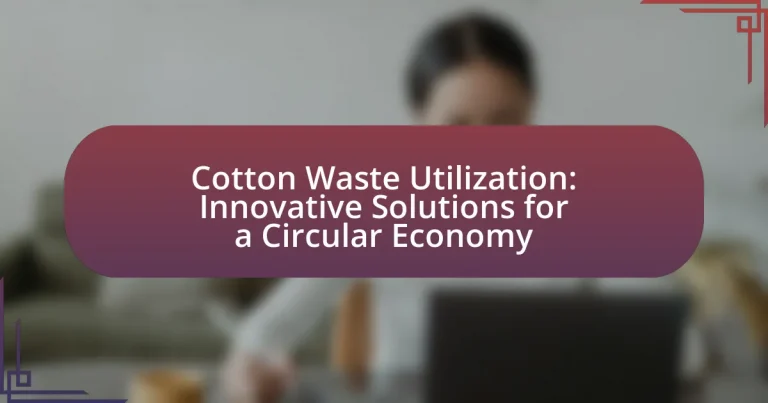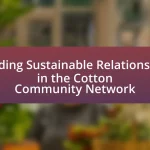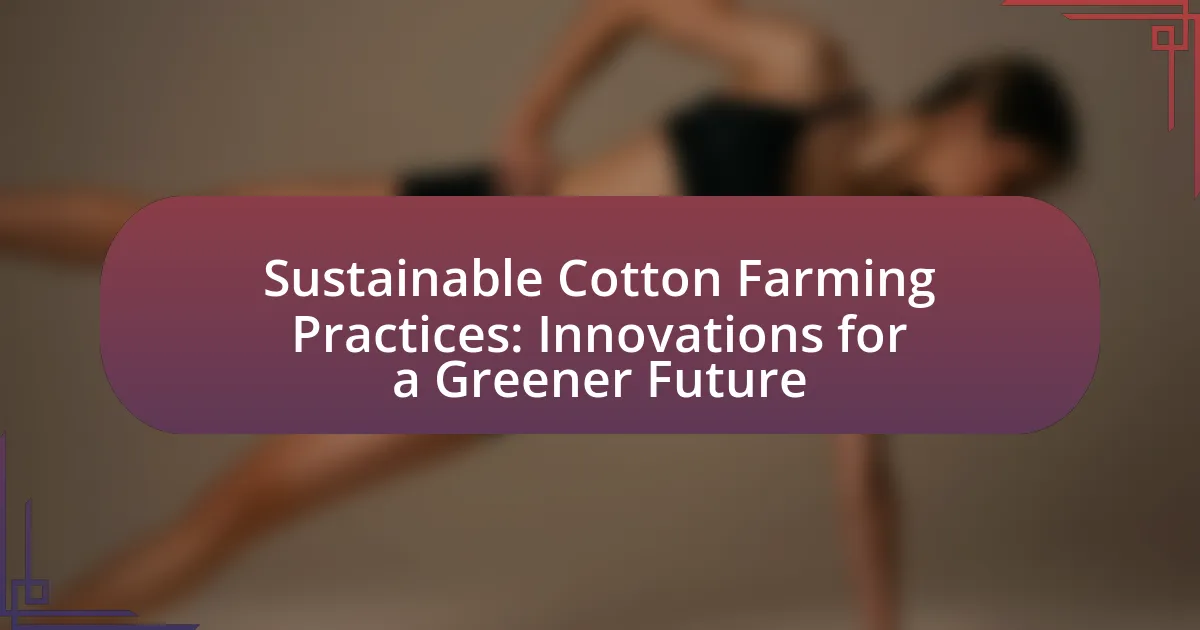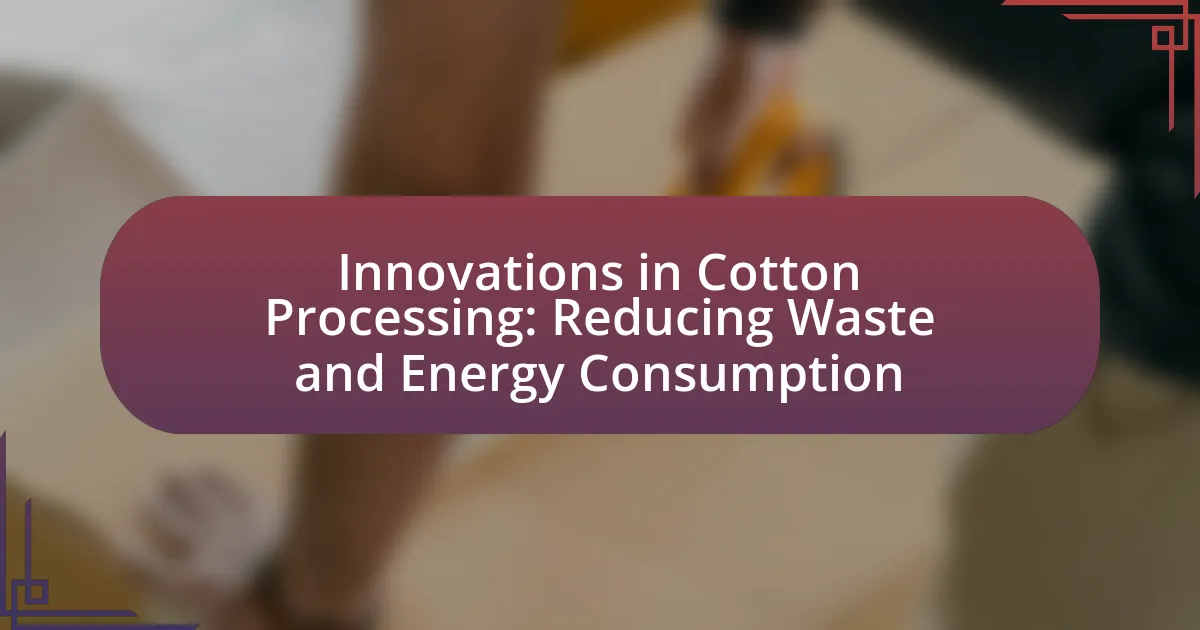Cotton waste utilization involves the repurposing and recycling of by-products generated during cotton production and processing, aiming to reduce waste and promote sustainability. The article explores the sources and generation of cotton waste in the textile industry, highlighting the significant environmental impacts and the importance of utilizing this waste for a circular economy. It discusses innovative solutions such as biodegradable textiles, biofuels, and composite materials, as well as the role of technology in enhancing cotton waste processing. Additionally, the article addresses the challenges and barriers to effective cotton waste utilization and outlines best practices and collaborative strategies for stakeholders to overcome these obstacles.
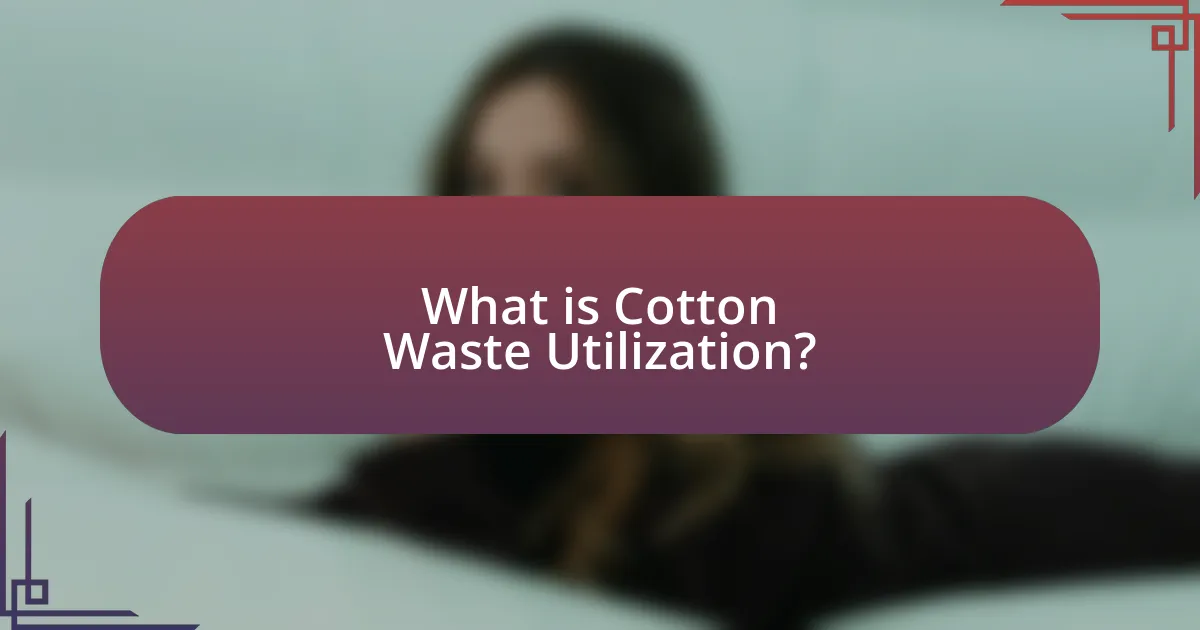
What is Cotton Waste Utilization?
Cotton waste utilization refers to the process of repurposing and recycling by-products generated during cotton production and processing. This includes using leftover fibers, seeds, and other materials to create new products, thereby reducing waste and promoting sustainability. For instance, according to the Textile World report, approximately 20% of cotton is lost during processing, and utilizing this waste can lead to the production of biodegradable materials, insulation, and even biofuels. This approach not only minimizes environmental impact but also contributes to a circular economy by ensuring that resources are reused and not discarded.
How is cotton waste generated in the textile industry?
Cotton waste is generated in the textile industry primarily during the processes of cotton cultivation, spinning, weaving, and garment manufacturing. During cultivation, leftover cotton fibers, seeds, and leaves contribute to waste. In spinning, short fibers that cannot be spun into yarn, known as “cotton linters,” are discarded. Weaving processes create waste from cuttings and defects in fabric. Additionally, garment manufacturing results in off-cuts and unsold inventory, further increasing cotton waste. According to the Textile Exchange, approximately 1.2 million tons of cotton waste are produced annually in the global textile industry, highlighting the significant scale of this issue.
What are the primary sources of cotton waste?
The primary sources of cotton waste include the production process, post-consumer textile waste, and agricultural by-products. During cotton production, waste is generated from the ginning process, where cotton fibers are separated from seeds, resulting in cottonseed hulls and linters. Additionally, post-consumer textile waste arises when discarded clothing and fabric scraps are not recycled or reused, contributing significantly to landfill waste. Agricultural by-products, such as stalks and leaves, also contribute to cotton waste, as they are often left unutilized after harvesting. According to the Textile Recycling Association, approximately 1.2 million tons of textile waste is generated annually in the UK alone, highlighting the scale of the issue.
How does the production process contribute to cotton waste?
The production process contributes to cotton waste primarily through inefficiencies in harvesting, processing, and manufacturing stages. During harvesting, mechanical methods can lead to the loss of cotton fibers, with estimates suggesting that up to 20% of cotton can be lost in the field due to improper techniques. In the processing phase, the ginning process separates seeds from fibers, generating waste; approximately 30% of the raw cotton is discarded as lint and seed waste. Additionally, during manufacturing, cutting and sewing operations often result in fabric scraps, with the fashion industry alone generating around 92 million tons of textile waste annually, a significant portion of which is cotton. These stages collectively contribute to substantial cotton waste, highlighting the need for improved practices and technologies to minimize losses.
Why is cotton waste utilization important for sustainability?
Cotton waste utilization is important for sustainability because it reduces environmental impact and promotes resource efficiency. By recycling cotton waste, the textile industry can minimize landfill contributions, which accounted for approximately 92 million tons of textile waste globally in 2021. Furthermore, utilizing cotton waste can lead to the production of new materials, such as biodegradable textiles and insulation products, thereby decreasing reliance on virgin resources and lowering carbon emissions associated with manufacturing. This approach aligns with circular economy principles, fostering a sustainable lifecycle for cotton products and contributing to overall ecological balance.
What environmental impacts does cotton waste have?
Cotton waste has significant environmental impacts, primarily contributing to soil degradation, water pollution, and greenhouse gas emissions. When cotton waste is disposed of improperly, it can release harmful chemicals into the soil and waterways, affecting local ecosystems. For instance, the decomposition of cotton waste in landfills generates methane, a potent greenhouse gas that contributes to climate change. Additionally, the production of cotton itself is resource-intensive, and the waste generated exacerbates the environmental footprint of cotton farming. According to the Food and Agriculture Organization, cotton cultivation accounts for 2.6% of global water use, and improper waste management can lead to further water scarcity issues.
How does cotton waste utilization contribute to a circular economy?
Cotton waste utilization contributes to a circular economy by transforming discarded cotton materials into valuable resources, thereby minimizing waste and promoting sustainability. This process includes recycling cotton waste into new textiles, creating biodegradable products, and generating energy through waste-to-energy technologies. For instance, the Global Fashion Agenda reports that recycling cotton can reduce greenhouse gas emissions by up to 50% compared to producing new cotton. By integrating cotton waste back into the production cycle, the industry reduces reliance on virgin materials, conserves natural resources, and decreases environmental impact, aligning with the principles of a circular economy.
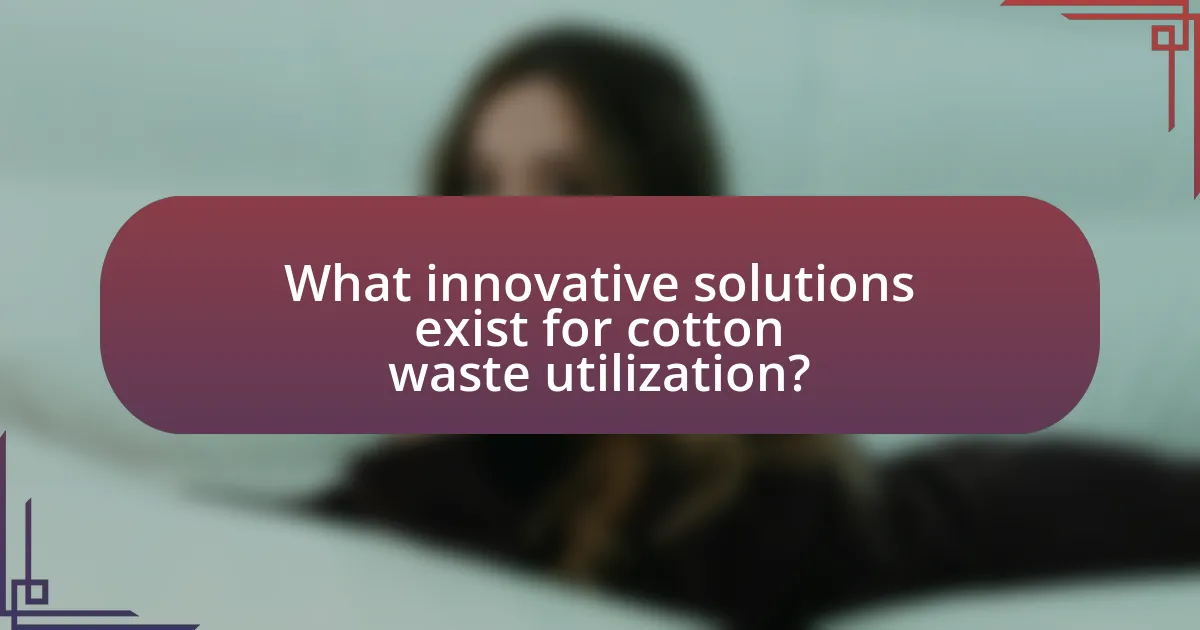
What innovative solutions exist for cotton waste utilization?
Innovative solutions for cotton waste utilization include the development of biodegradable textiles, the production of biofuels, and the creation of composite materials. Biodegradable textiles, made from cotton waste, can decompose naturally, reducing landfill impact. Research indicates that converting cotton waste into biofuels can provide a sustainable energy source, with studies showing that cotton biomass can yield significant energy outputs. Additionally, composite materials incorporating cotton waste have been shown to enhance the mechanical properties of products, making them suitable for various applications in construction and automotive industries. These solutions contribute to a circular economy by minimizing waste and promoting resource efficiency.
How can cotton waste be transformed into new products?
Cotton waste can be transformed into new products through processes such as recycling, upcycling, and conversion into bio-based materials. Recycling involves breaking down cotton waste into fibers that can be spun into new yarns, which can then be woven into fabrics. Upcycling can create items like insulation, stuffing for pillows, or even fashion accessories, enhancing the value of the waste material. Additionally, cotton waste can be converted into bio-based materials, such as biodegradable plastics or composite materials, contributing to sustainable product development. For instance, a study published in the Journal of Cleaner Production highlights that recycling cotton waste can reduce landfill waste by up to 90%, demonstrating the effectiveness of these transformation methods in promoting a circular economy.
What are the methods for recycling cotton waste?
The methods for recycling cotton waste include mechanical recycling, chemical recycling, and thermal recycling. Mechanical recycling involves shredding cotton waste into smaller fibers, which can then be spun into new yarns or fabrics. Chemical recycling breaks down cotton fibers into their basic components, allowing for the creation of new fibers or materials. Thermal recycling utilizes heat to convert cotton waste into energy or other usable forms. These methods contribute to reducing textile waste and promoting sustainability in the fashion industry.
How can cotton waste be used in the production of biodegradable materials?
Cotton waste can be used in the production of biodegradable materials by processing it into cellulose-based bioplastics. This transformation utilizes the natural cellulose fibers found in cotton, which can be chemically treated to create biodegradable polymers. Research indicates that these cellulose-derived materials can decompose in natural environments, reducing plastic waste. For instance, a study published in the journal “Biomacromolecules” demonstrates that cellulose from cotton waste can be effectively converted into films and coatings that are both biodegradable and functional, supporting sustainable material development.
What role does technology play in cotton waste utilization?
Technology plays a crucial role in cotton waste utilization by enabling efficient processing and conversion of waste into valuable products. Advanced techniques such as enzymatic treatments, mechanical recycling, and chemical processes allow for the transformation of cotton waste into materials like biofuels, textiles, and biodegradable plastics. For instance, research has shown that enzymatic processes can break down cotton fibers into glucose, which can then be fermented into bioethanol, providing a sustainable energy source. Additionally, innovations in textile recycling technology have increased the recovery rates of cotton fibers from waste, promoting a circular economy and reducing environmental impact.
How are advancements in technology improving cotton waste processing?
Advancements in technology are significantly improving cotton waste processing by enabling more efficient recycling and conversion methods. Innovations such as enzymatic treatments and advanced mechanical processes allow for the breakdown of cotton waste into valuable byproducts, such as biofuels and biodegradable materials. For instance, research has shown that using specific enzymes can enhance the degradation of cotton fibers, leading to higher yields of usable products. Additionally, technologies like artificial intelligence and machine learning optimize sorting and processing operations, reducing waste and increasing the overall efficiency of cotton waste management systems. These advancements contribute to a more sustainable circular economy by minimizing environmental impact and maximizing resource recovery.
What innovative startups are leading the way in cotton waste solutions?
Innovative startups leading the way in cotton waste solutions include Worn Again Technologies, which focuses on recycling cotton waste into new textiles, and Re:newcell, known for its process of turning cotton waste into dissolving pulp for new fabric production. These companies exemplify advancements in sustainable practices, with Worn Again Technologies aiming to create a closed-loop system and Re:newcell achieving significant reductions in water and energy usage compared to traditional textile production methods.

What are the challenges in cotton waste utilization?
The challenges in cotton waste utilization include the lack of efficient processing technologies, economic viability, and market demand for recycled products. Efficient processing technologies are essential for converting cotton waste into usable materials, but many existing methods are not cost-effective or scalable. Economic viability is a significant barrier, as the costs associated with collection, processing, and distribution can exceed the potential revenue from recycled cotton products. Additionally, market demand for recycled cotton is limited, as consumers often prefer new materials, which hinders the growth of a sustainable cotton waste recycling industry. These challenges collectively impede the effective utilization of cotton waste in a circular economy.
What barriers exist in the adoption of cotton waste utilization practices?
Barriers in the adoption of cotton waste utilization practices include economic constraints, lack of awareness, and insufficient infrastructure. Economic constraints arise from the high initial investment required for technology and processes to convert cotton waste into usable products, which can deter stakeholders. Lack of awareness among farmers and manufacturers about the benefits and methods of cotton waste utilization further hampers adoption. Additionally, insufficient infrastructure for collection, processing, and distribution of cotton waste limits the feasibility of implementing these practices effectively. These barriers collectively hinder the transition towards a circular economy in the cotton industry.
How do economic factors influence cotton waste recycling efforts?
Economic factors significantly influence cotton waste recycling efforts by determining the cost-effectiveness and viability of recycling processes. For instance, fluctuations in cotton prices can impact the profitability of recycling operations; when cotton prices are high, the incentive to recycle cotton waste increases as it can be transformed into valuable products. Additionally, government policies and subsidies aimed at promoting sustainable practices can enhance the financial feasibility of recycling initiatives. According to a study published in the Journal of Cleaner Production, regions with supportive economic policies saw a 30% increase in recycling rates compared to those without such incentives. Thus, economic conditions directly shape the landscape of cotton waste recycling by affecting both the motivation and resources available for these efforts.
What regulatory challenges impact cotton waste management?
Regulatory challenges impacting cotton waste management include stringent environmental regulations, lack of standardized waste classification, and inadequate enforcement mechanisms. Environmental regulations often require compliance with waste disposal and recycling standards, which can be complex and costly for cotton producers and processors. The absence of standardized waste classification complicates the identification and management of cotton waste, leading to inconsistent practices across the industry. Additionally, inadequate enforcement mechanisms can result in non-compliance, undermining efforts to promote sustainable waste management practices. These challenges hinder the effective implementation of circular economy principles in cotton waste utilization.
How can stakeholders overcome these challenges?
Stakeholders can overcome challenges in cotton waste utilization by implementing collaborative strategies that enhance resource efficiency and innovation. By forming partnerships among cotton producers, manufacturers, and researchers, stakeholders can share knowledge and develop new technologies for recycling and repurposing cotton waste. For instance, the establishment of industry consortia can facilitate the exchange of best practices and drive investment in sustainable practices. Additionally, stakeholders can advocate for supportive policies and incentives that promote circular economy initiatives, as evidenced by the European Union’s Circular Economy Action Plan, which aims to reduce waste and improve resource efficiency across sectors.
What best practices can industries adopt for effective cotton waste utilization?
Industries can adopt several best practices for effective cotton waste utilization, including recycling, upcycling, and converting waste into bioenergy. Recycling involves processing cotton waste into new textile products, which can significantly reduce landfill contributions and resource consumption. Upcycling transforms waste into higher-value products, such as insulation materials or fashion items, thereby enhancing economic value. Converting cotton waste into bioenergy through anaerobic digestion or combustion can provide renewable energy sources, contributing to sustainability goals. According to the Textile Recycling Association, recycling one ton of cotton can save approximately 7,000 gallons of water and reduce greenhouse gas emissions, demonstrating the environmental benefits of these practices.
How can collaboration among stakeholders enhance cotton waste solutions?
Collaboration among stakeholders can significantly enhance cotton waste solutions by pooling resources, expertise, and innovative ideas. When farmers, manufacturers, researchers, and policymakers work together, they can develop more effective recycling processes and sustainable practices. For instance, a study by the Textile Recycling Association found that collaborative initiatives can increase the recycling rate of cotton waste by up to 30%, demonstrating the tangible benefits of shared knowledge and technology. Additionally, partnerships can lead to the creation of new markets for recycled cotton products, further driving economic viability and environmental sustainability in the cotton industry.
What are practical steps for businesses to implement cotton waste utilization?
Businesses can implement cotton waste utilization by adopting several practical steps. First, they should conduct an audit of their cotton waste to identify the types and quantities generated during production. This data will help in determining the most effective utilization methods. Next, companies can explore partnerships with recycling firms that specialize in textile waste to convert cotton scraps into new products, such as insulation materials or biodegradable packaging.
Additionally, businesses can invest in technology that enables the processing of cotton waste into yarn or fabric, thereby creating a closed-loop system. Training employees on sustainable practices and the importance of waste reduction can further enhance these efforts. According to the Textile Recycling Association, recycling one ton of cotton can save approximately 7,000 gallons of water, highlighting the environmental benefits of effective cotton waste utilization.
